ECU VOLVO V60 2014 Owners Manual
[x] Cancel search | Manufacturer: VOLVO, Model Year: 2014, Model line: V60, Model: VOLVO V60 2014Pages: 442, PDF Size: 13.85 MB
Page 17 of 442
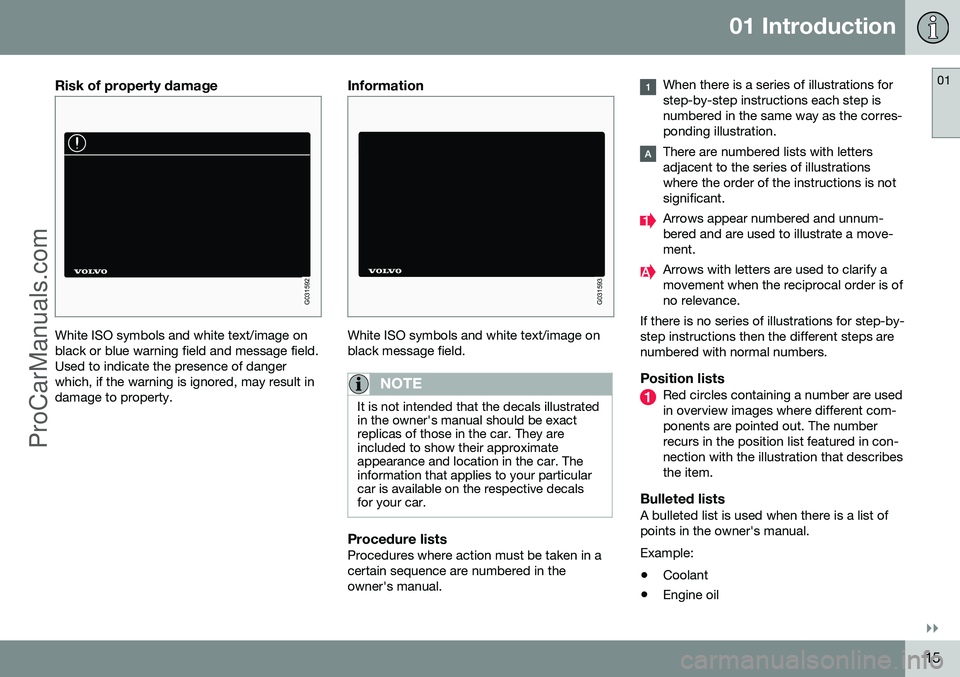
01 Introduction
01
}}
15
Risk of property damage
G031592
White ISO symbols and white text/image on black or blue warning field and message field.Used to indicate the presence of dangerwhich, if the warning is ignored, may result indamage to property.
Information
G031593
White ISO symbols and white text/image on black message field.
NOTE
It is not intended that the decals illustrated in the owner's manual should be exactreplicas of those in the car. They areincluded to show their approximateappearance and location in the car. Theinformation that applies to your particularcar is available on the respective decalsfor your car.
Procedure listsProcedures where action must be taken in a certain sequence are numbered in theowner's manual.
When there is a series of illustrations for step-by-step instructions each step isnumbered in the same way as the corres-ponding illustration.
There are numbered lists with letters adjacent to the series of illustrationswhere the order of the instructions is notsignificant.
Arrows appear numbered and unnum- bered and are used to illustrate a move-ment.
Arrows with letters are used to clarify a movement when the reciprocal order is ofno relevance.
If there is no series of illustrations for step-by-step instructions then the different steps arenumbered with normal numbers.
Position listsRed circles containing a number are used in overview images where different com-ponents are pointed out. The numberrecurs in the position list featured in con-nection with the illustration that describesthe item.
Bulleted listsA bulleted list is used when there is a list ofpoints in the owner's manual. Example:
• Coolant
• Engine oil
ProCarManuals.co’
Page 18 of 442
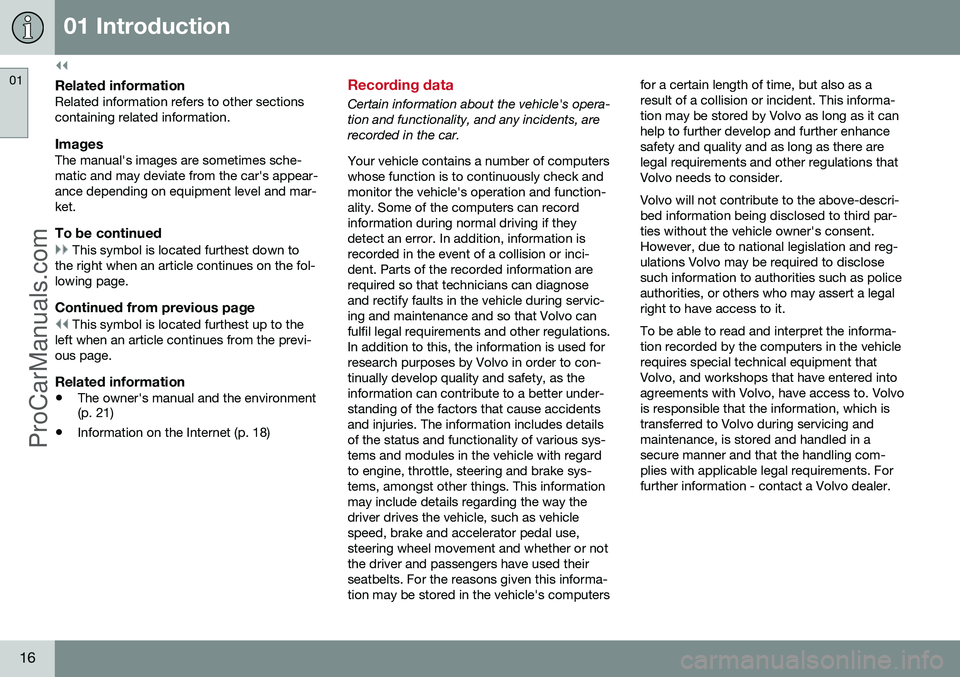
||
01 Introduction
01
16
Related informationRelated information refers to other sections containing related information.
ImagesThe manual's images are sometimes sche-matic and may deviate from the car's appear-ance depending on equipment level and mar-ket.
To be continued
}} This symbol is located furthest down to
the right when an article continues on the fol- lowing page.
Continued from previous page
| | This symbol is located furthest up to the
left when an article continues from the previ- ous page.
Related information
• The owner's manual and the environment (p. 21)
• Information on the Internet (p. 18)
Recording data
Certain information about the vehicle's opera- tion and functionality, and any incidents, arerecorded in the car. Your vehicle contains a number of computers whose function is to continuously check andmonitor the vehicle's operation and function-ality. Some of the computers can recordinformation during normal driving if theydetect an error. In addition, information isrecorded in the event of a collision or inci-dent. Parts of the recorded information arerequired so that technicians can diagnoseand rectify faults in the vehicle during servic-ing and maintenance and so that Volvo canfulfil legal requirements and other regulations.In addition to this, the information is used forresearch purposes by Volvo in order to con-tinually develop quality and safety, as theinformation can contribute to a better under-standing of the factors that cause accidentsand injuries. The information includes detailsof the status and functionality of various sys-tems and modules in the vehicle with regardto engine, throttle, steering and brake sys-tems, amongst other things. This informationmay include details regarding the way thedriver drives the vehicle, such as vehiclespeed, brake and accelerator pedal use,steering wheel movement and whether or notthe driver and passengers have used theirseatbelts. For the reasons given this informa-tion may be stored in the vehicle's computers for a certain length of time, but also as aresult of a collision or incident. This informa-tion may be stored by Volvo as long as it canhelp to further develop and further enhancesafety and quality and as long as there arelegal requirements and other regulations thatVolvo needs to consider. Volvo will not contribute to the above-descri- bed information being disclosed to third par-ties without the vehicle owner's consent.However, due to national legislation and reg-ulations Volvo may be required to disclosesuch information to authorities such as policeauthorities, or others who may assert a legalright to have access to it. To be able to read and interpret the informa- tion recorded by the computers in the vehiclerequires special technical equipment thatVolvo, and workshops that have entered intoagreements with Volvo, have access to. Volvois responsible that the information, which istransferred to Volvo during servicing andmaintenance, is stored and handled in asecure manner and that the handling com-plies with applicable legal requirements. Forfurther information - contact a Volvo dealer.
ProCarManuals.co’
Page 19 of 442

01 Introduction
01
* Option/accessory, for more information, see Introduction.17
Accessories and extra equipment
The incorrect connection and installation of accessories and extra equipment can nega-tively affect the car's electronic system. Certain accessories only function when asso- ciated software is installed in the car's com-puter system. Volvo therefore recommendsthat you always contact an authorised Volvoworkshop before installing accessories orextra equipment which are connected to oraffect the electrical system.
Heat-reflecting windscreen*
Areas where IR film is not applied.
Dimensions
A40 mm
B80 mm
The windscreen is equipped with a heat- reflecting film (IR) that reduces the solar heatradiation into the passenger compartment. The positioning of electronic equipment, such as a transponder, behind a glass surface withheat-reflecting film may affect its function andperformance. For the optimal function of electronic equip- ment, it should be positioned on the part ofthe windscreen with no heat-reflecting film(see the highlighted area in the above illustra-tion).Change of ownership for cars with Volvo On Call*
If the car is equipped with Volvo On Call, VOC it is important to change the owner of theservice. VOC is a supplemental service that consists of safety, security and comfort services. Inthe event of change of ownership it is impor-tant to change the owner of the service.
Closing the VOC serviceContact a Volvo dealer in the event of changeof ownership in order to close the VOC serv-ice. In the event of change of ownership it is important to reset personal settings in the car to the original factory settings 2
, see Change
of ownership.
Starting the VOC serviceIt is very important that the VOC service changes owner so that the previous owner'sability to use services in the car is stopped.Contact a Volvo dealer in the event of achange of ownership.
Related information
• Information on the Internet (p. 18)
ProCarManuals.co’
Page 26 of 442

02 Safety
02
24
Seatbelt - putting on
Put on the seatbelt (p. 23) before setting off. Pull the belt out slowly and secure it by pressing its locking tab into the seatbeltbuckle. A loud "click" indicates that the belthas locked.
Correctly fitted seatbelt.
Incorrectly fitted seatbelt. The belt must rest on the shoulder.
Seatbelt height adjustment. Press the button and move the belt vertically. Position the belt as highas possible without it chafing against your throat.
The buckles only fit the intended lock in the rear seat 1
.
RememberThe seatbelt locks and cannot be withdrawn: • if it is pulled out too quickly
• during braking and acceleration
• if the car leans heavily.
Related information
•Seatbelt - pregnancy (p. 25)
• Seat belt - loosening (p. 25)
• Seatbelt tensioner (p. 26)
• Seatbelt reminder (p. 26)
1
Certain markets.
ProCarManuals.co’
Page 31 of 442
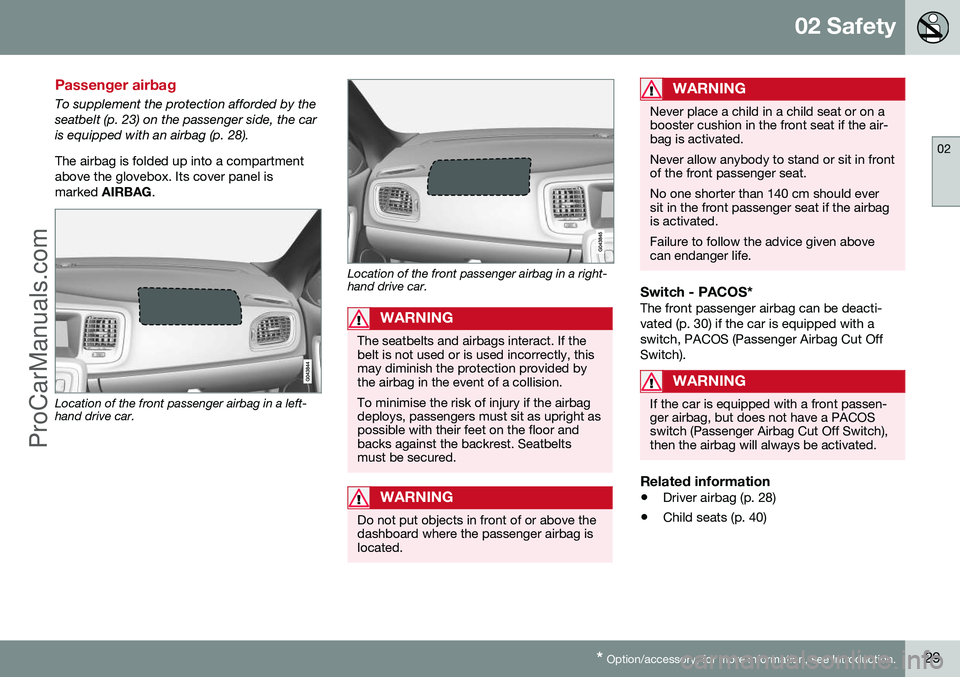
02 Safety
02
* Option/accessory, for more information, see Introduction.29
Passenger airbag
To supplement the protection afforded by the seatbelt (p. 23) on the passenger side, the caris equipped with an airbag (p. 28). The airbag is folded up into a compartment above the glovebox. Its cover panel ismarked AIRBAG .
Location of the front passenger airbag in a left- hand drive car.
Location of the front passenger airbag in a right- hand drive car.
WARNING
The seatbelts and airbags interact. If the belt is not used or is used incorrectly, thismay diminish the protection provided bythe airbag in the event of a collision. To minimise the risk of injury if the airbag deploys, passengers must sit as upright aspossible with their feet on the floor andbacks against the backrest. Seatbeltsmust be secured.
WARNING
Do not put objects in front of or above the dashboard where the passenger airbag islocated.
WARNING
Never place a child in a child seat or on a booster cushion in the front seat if the air-bag is activated. Never allow anybody to stand or sit in front of the front passenger seat. No one shorter than 140 cm should ever sit in the front passenger seat if the airbagis activated. Failure to follow the advice given above can endanger life.
Switch - PACOS*The front passenger airbag can be deacti- vated (p. 30) if the car is equipped with aswitch, PACOS (Passenger Airbag Cut OffSwitch).
WARNING
If the car is equipped with a front passen- ger airbag, but does not have a PACOSswitch (Passenger Airbag Cut Off Switch),then the airbag will always be activated.
Related information
•Driver airbag (p. 28)
• Child seats (p. 40)
ProCarManuals.co’
Page 41 of 442
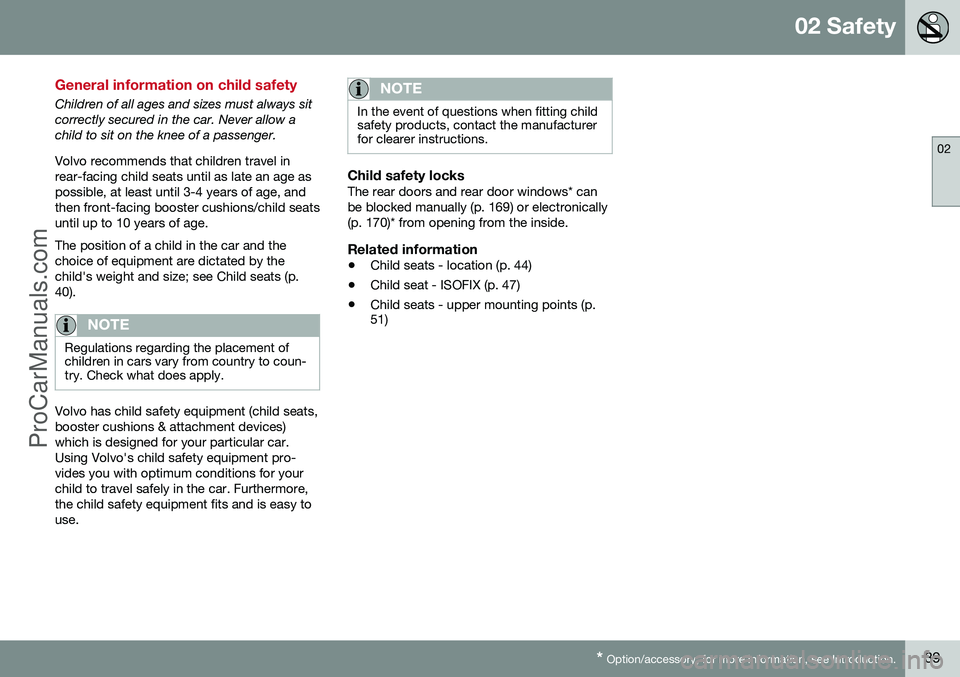
02 Safety
02
* Option/accessory, for more information, see Introduction.39
General information on child safety
Children of all ages and sizes must always sit correctly secured in the car. Never allow achild to sit on the knee of a passenger. Volvo recommends that children travel in rear-facing child seats until as late an age aspossible, at least until 3-4 years of age, andthen front-facing booster cushions/child seatsuntil up to 10 years of age. The position of a child in the car and the choice of equipment are dictated by thechild's weight and size; see Child seats (p.40).
NOTE
Regulations regarding the placement of children in cars vary from country to coun-try. Check what does apply.
Volvo has child safety equipment (child seats, booster cushions & attachment devices)which is designed for your particular car.Using Volvo's child safety equipment pro-vides you with optimum conditions for yourchild to travel safely in the car. Furthermore,the child safety equipment fits and is easy touse.
NOTE
In the event of questions when fitting child safety products, contact the manufacturerfor clearer instructions.
Child safety locksThe rear doors and rear door windows* can be blocked manually (p. 169) or electronically(p. 170)* from opening from the inside.
Related information
• Child seats - location (p. 44)
• Child seat - ISOFIX (p. 47)
• Child seats - upper mounting points (p. 51)
ProCarManuals.co’
Page 42 of 442
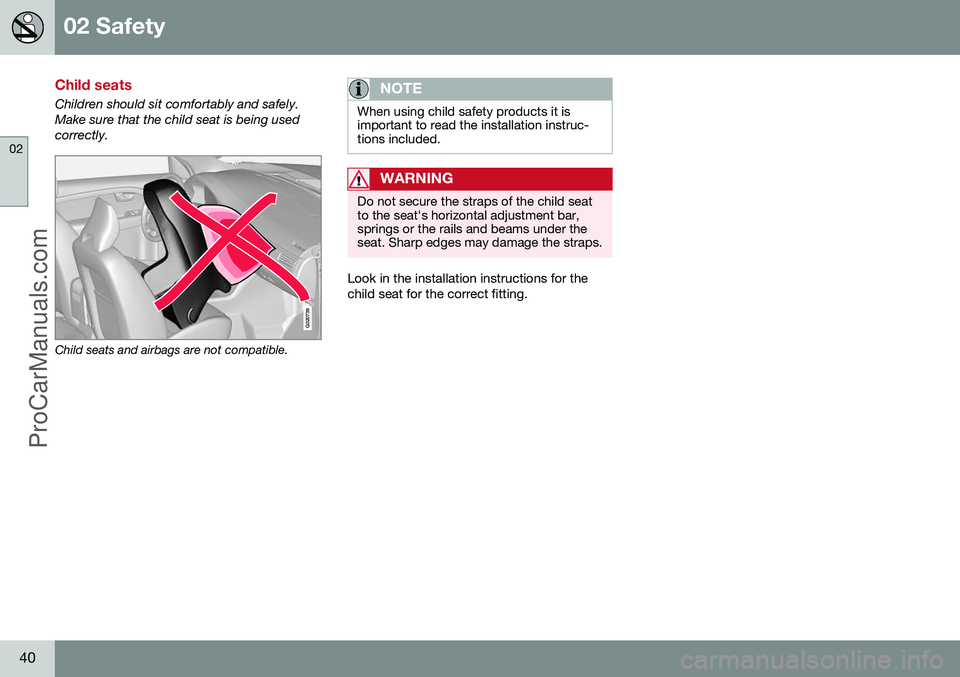
02 Safety
02
40
Child seats
Children should sit comfortably and safely. Make sure that the child seat is being usedcorrectly.
G020739
Child seats and airbags are not compatible.
NOTE
When using child safety products it is important to read the installation instruc-tions included.
WARNING
Do not secure the straps of the child seat to the seat's horizontal adjustment bar,springs or the rails and beams under theseat. Sharp edges may damage the straps.
Look in the installation instructions for the child seat for the correct fitting.
ProCarManuals.co’
Page 43 of 442

02 Safety
02
}}
41
Recommended child seats2
WeightFront seat (with deactivated airbag)Outer rear seatCentre rear seat
Group 0 max 10 kg Group 0+ max 13 kgVolvo infant seat (Volvo Infant Seat) - rear-facing child seat, secured with the ISOFIX fixture system. Type approval: E1 04301146(L)
Group 0 max 10 kg Group 0+ max 13 kgVolvo infant seat (Volvo Infant Seat) - rear- facing child seat, secured with the car'sseatbelt. Type approval: E1 04301146(U)Volvo infant seat (Volvo Infant Seat) - rear-facing child seat, secured with the car's seatbelt. Type approval: E1 04301146(U)Volvo infant seat (Volvo Infant Seat) - rear-facing child seat,secured with the car's seatbelt. Type approval: E1 04301146(U)
Group 0 max 10 kg Group 0+ max 13 kgChild seats which are universally approved. (U)Child seats which are universally approved. (U)Child seats which are univer- sally approved. (U)
Group 1 9-18 kgVolvo rear-facing/turnable child seat (Volvo Convertible Child Seat) - rear-facing childseat, secured with the car's seatbelt andstraps. Type approval: E5 04192(L)Volvo rear-facing/turnable child seat (Volvo Convertible Child Seat) - rear-facing child seat,secured with the car's seatbelt and straps. Type approval: E5 04192(L)
2
With regard to other child seats your car should be included in the manufacturer's enclosed list of vehicles or be universally approved in accordance with the ECE R44 legal requirement.
ProCarManuals.co’
Page 44 of 442
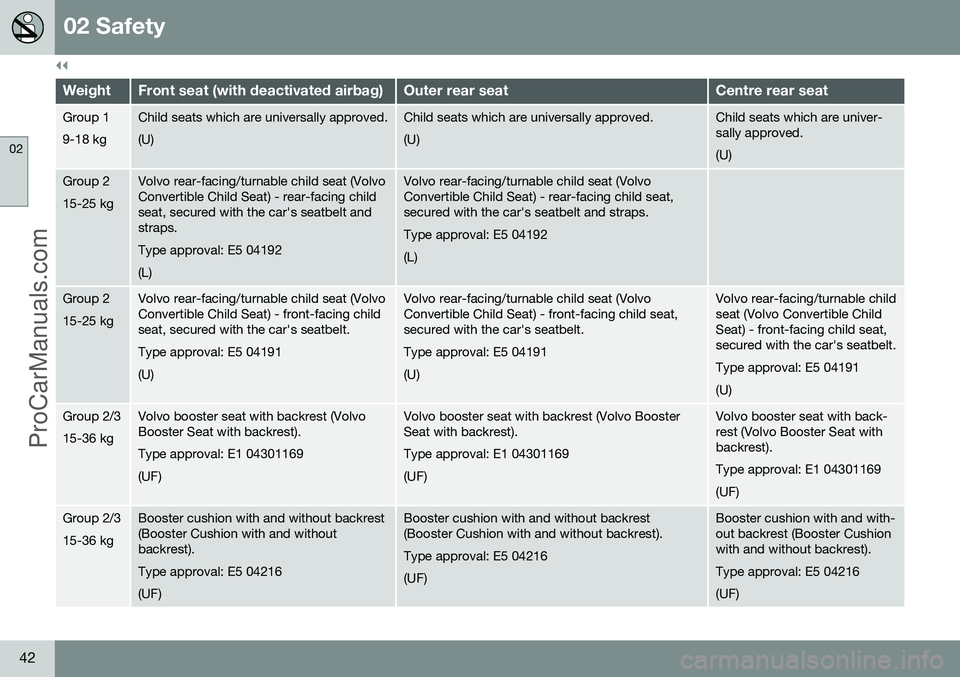
||
02 Safety
02
42
WeightFront seat (with deactivated airbag)Outer rear seatCentre rear seat
Group 1 9-18 kgChild seats which are universally approved. (U)Child seats which are universally approved. (U)Child seats which are univer- sally approved. (U)
Group 2 15-25 kgVolvo rear-facing/turnable child seat (Volvo Convertible Child Seat) - rear-facing childseat, secured with the car's seatbelt andstraps. Type approval: E5 04192(L)Volvo rear-facing/turnable child seat (Volvo Convertible Child Seat) - rear-facing child seat,secured with the car's seatbelt and straps. Type approval: E5 04192(L)
Group 2 15-25 kgVolvo rear-facing/turnable child seat (Volvo Convertible Child Seat) - front-facing childseat, secured with the car's seatbelt. Type approval: E5 04191(U)Volvo rear-facing/turnable child seat (Volvo Convertible Child Seat) - front-facing child seat,secured with the car's seatbelt. Type approval: E5 04191(U)Volvo rear-facing/turnable child seat (Volvo Convertible ChildSeat) - front-facing child seat,secured with the car's seatbelt. Type approval: E5 04191(U)
Group 2/3 15-36 kgVolvo booster seat with backrest (Volvo Booster Seat with backrest). Type approval: E1 04301169(UF)Volvo booster seat with backrest (Volvo Booster Seat with backrest). Type approval: E1 04301169(UF)Volvo booster seat with back- rest (Volvo Booster Seat withbackrest). Type approval: E1 04301169(UF)
Group 2/3 15-36 kgBooster cushion with and without backrest (Booster Cushion with and withoutbackrest). Type approval: E5 04216(UF)Booster cushion with and without backrest (Booster Cushion with and without backrest). Type approval: E5 04216(UF)Booster cushion with and with- out backrest (Booster Cushionwith and without backrest). Type approval: E5 04216(UF)
ProCarManuals.co’
Page 49 of 442
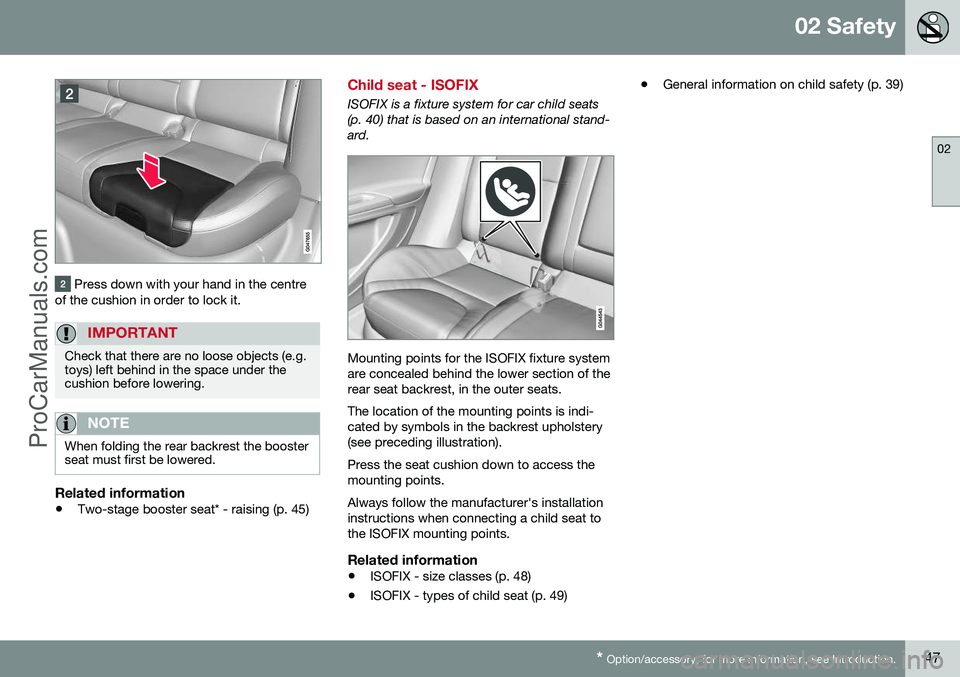
02 Safety
02
* Option/accessory, for more information, see Introduction.47
Press down with your hand in the centre
of the cushion in order to lock it.
IMPORTANT
Check that there are no loose objects (e.g. toys) left behind in the space under thecushion before lowering.
NOTE
When folding the rear backrest the booster seat must first be lowered.
Related information
• Two-stage booster seat* - raising (p. 45)
Child seat - ISOFIX
ISOFIX is a fixture system for car child seats (p. 40) that is based on an international stand-ard.
Mounting points for the ISOFIX fixture system are concealed behind the lower section of therear seat backrest, in the outer seats. The location of the mounting points is indi- cated by symbols in the backrest upholstery(see preceding illustration). Press the seat cushion down to access the mounting points. Always follow the manufacturer's installation instructions when connecting a child seat tothe ISOFIX mounting points.
Related information
•ISOFIX - size classes (p. 48)
• ISOFIX - types of child seat (p. 49) •
General information on child safety (p. 39)
ProCarManuals.co’